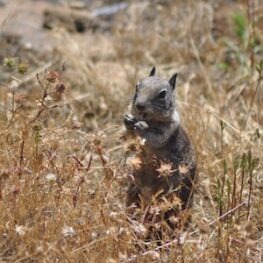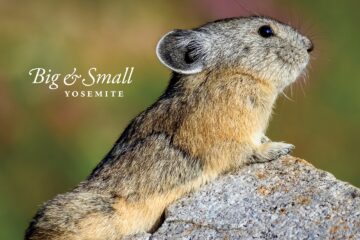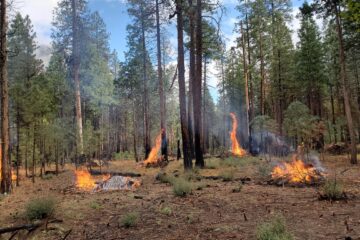Photo credit: Caitlin Lee-Roney
By Cory Goehring, Senior Naturalist
Yosemite National Park is an iconic place, renowned for its towering cliffs and thundering waterfalls. It was here that the idea for the National Park system was born. Today, millions of visitors flock from around the world to experience Yosemite’s natural beauty and for some, their visit is highlighted by their first Yosemite wildlife encounter in a wilderness setting.
When coming to a national park to view wildlife it is important to keep a few safety tips in mind — for your safety AND the safety of the wildlife. First, never feed an animal in a national park. They are wild animals and eat natural foods found in their habitat. Animals fed by humans can become aggressive, sick, or dead. Additionally, you should never approach or touch wildlife. We are guests in their home, and they need their space.
1. Ursus americanus, the black bear
Of the iconic species found in Yosemite, one of the most famous and most thought of is the black bear (Ursus americanus). Most visitors come into the park hoping for the chance encounter of seeing a bear in Yosemite. People often venture to the informational centers of Yosemite requesting where the best place is to possibly see a bear and some even hike all day in hopes of catching a glimpse of the iconic species. For many the black bear is the species that defines Yosemite wildlife.
An estimated 300 to 500 black bears call Yosemite home at any given time and while most visitors envision a black-colored bear, 90% of the bears in Yosemite are brown to blonde in color. Seeing one of these animals in their natural habitat is a unique Yosemite experience that often defines a visitor’s time in the park.
It is important to give black bears and all Yosemite wildlife ample space. The park recommends you maintain at least 50 yards. If you stretch your arm out in front of your face and create a thumbs up with your handle then your thumb should be able to completely cover the bear. If the bear is bigger than your thumb you should back away safely and slowly. Read more on Yosemite’s specific bear guidelines.
Yosemite also has an extensive Human-Bear Management Program to keep both bears and people safe. These rangers not only monitor bear behavior and the health of the species but also provide education on how to be “bear aware” and store food and scented items properly. Through funding from Yosemite Conservancy donors, rangers carefully track the park’s bears that enter Yosemite Valley by tagging their ears and even outfitting some with GPS collars. Historical data from these collared bears is available online, allowing you to follow their far-ranging travels through the park’s wilderness.
2. Odocoileus hemionus, the mule deer

Classic Yosemite wildlife moment: Mule deer grazing in a meadow.
Another iconic and popular Yosemite wildlife species is the mule deer (Odocoileus hemionus). The first thing many notice about mule deer are their large, mule-like ears — giving them both their name and excellent hearing ability. Their tall ears allow the mule deer to pick up even the slightest dangers like approaching predators. Their huge ears are perfect for Yosemite’s meadows and oak woodlands where keen senses provide an advantage.
Mule deer are also powerful jumpers, thanks to their elongated rear legs. This allows them to jump effortlessly over logs and shrubs with just a few strides. In Yosemite’s rocky high country, their jumping prowess helps them navigate the craggy terrain with surprising agility.
Yosemite’s long-protected status has allowed the deer population to thrive to the point that many individuals show little fear of humans. While this can create great viewing opportunities, it also leads to danger, people have been known to be attacked by dear in Yosemite by getting too close, especially in the fall when deer are mating.
Tragically, there has even been a fatal deer attack in the park. Many visitors are surprised to find out that the mule deer is one of the most dangerous animals in Yosemite. Always remember to keep your distance from wildlife in Yosemite no matter how accepting of your presence they may seem to be and remember to never feed wildlife.
3. Otospermophilus beecheyi, the California ground squirrel

California ground squirrel enjoying a healthy lunch of seeds and nuts.
One species of Yosemite wildlife that visitors may not initially consider iconic, but which nearly all will encounter, is the California ground squirrel (Otospermophilus beecheyi). Despite their small stature, California ground squirrels are remarkably fascinating creatures with some extraordinary traits.
As the senior naturalist, I find these amusing little creatures fascinating. Living in extensive burrow systems, each ground squirrel has its own entrance connecting to the underground tunnel systems.
Perhaps their most impressive adaptation is their immunity to rattlesnake venom. Researchers have discovered these squirrels have varying levels of venom-resistance as adults. Even more incredible, mother squirrels gather shed rattlesnake skins, lick them, and then transfer the scent to their pups — helping disguise the young from hungry rattlers before they develop venom-immunity. When confronted by a rattler, ground squirrels also engage in dramatic behaviors like sand-kicking, tail-waving, and even heating up their tails with blood to appear larger and convey they aren’t worth the effort to hunt. With remarkable strategies like these, it’s no wonder the ground squirrel is so prevalent in Yosemite.
While Yosemite’s dramatic scenery is enough to take one’s breath away, it is the chance to of some of the iconic Yosemite wildlife like black bears, mule deer, or yes, even ground squirrels in their natural habitats that elevate a trip here in Yosemite into the truly memorable experience. By protecting this wilderness and supporting the park through Yosemite Conservancy, we can all help preserve a living piece of the wild California that once was.
And, if you’re still hungry for more learning about Yosemite wildlife, check out our naturalist-led Outdoor Adventures programs — especially our Yosemite Field School trips. Many of these trips will teach you all about specific wildlife in Yosemite and may even get you an opportunity to spot them in the wild.
Yosemite wildlife photo credits:
Mule deer by Lorena L Sanchez
Ground squirrel by NPS/Christine Singfield



